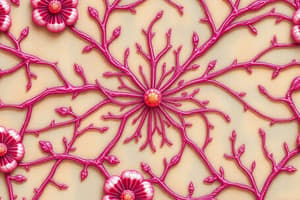Podcast
Questions and Answers
Which type of epithelial tissue primarily functions in absorption and secretion?
Which type of epithelial tissue primarily functions in absorption and secretion?
- Squamous epithelium
- Columnar epithelium (correct)
- Cuboidal epithelium (correct)
- Ciliated epithelium
What is the primary role of areolar connective tissue?
What is the primary role of areolar connective tissue?
- To fill spaces between tissues and organs (correct)
- To connect muscles to bones
- To provide structural support to cartilage
- To store fat for insulation
Which type of cartilage is primarily found in the intervertebral disks?
Which type of cartilage is primarily found in the intervertebral disks?
- Fibrocartilage (correct)
- Elastic cartilage
- Reticular cartilage
- Hyaline cartilage
What is the main distinguishing feature of dense connective tissue?
What is the main distinguishing feature of dense connective tissue?
What is the function of mast cells in connective tissue?
What is the function of mast cells in connective tissue?
Which mineral compounds contribute to the hardness of bone tissue?
Which mineral compounds contribute to the hardness of bone tissue?
Which type of tissue serves as the framework for organs such as the liver and spleen?
Which type of tissue serves as the framework for organs such as the liver and spleen?
What type of epithelial tissue is characterized by flat cells and is involved in diffusion?
What type of epithelial tissue is characterized by flat cells and is involved in diffusion?
What is the primary function of Kupffer's cells?
What is the primary function of Kupffer's cells?
Which epithelial cell type is specifically designed for secretion and absorption?
Which epithelial cell type is specifically designed for secretion and absorption?
Which type of connective tissue has the function of insulating and maintaining temperature?
Which type of connective tissue has the function of insulating and maintaining temperature?
What characterizes pseudostratified epithelium?
What characterizes pseudostratified epithelium?
Which statement accurately describes the role of lymphoid tissue?
Which statement accurately describes the role of lymphoid tissue?
What is the main role of synovial membranes?
What is the main role of synovial membranes?
Which of the following connective tissue functions is NOT performed by blood?
Which of the following connective tissue functions is NOT performed by blood?
What distinguishes simple epithelium from stratified epithelium?
What distinguishes simple epithelium from stratified epithelium?
Flashcards are hidden until you start studying
Study Notes
Epithelial Tissue
- Functions in protection, absorption, secretion, and excretion
- Cells are closely packed with minimal intercellular material
- Attached to the basement membrane for support
- Classified by shape, arrangement, and function
Connective Tissue
- Composed of cells embedded in a matrix of intercellular material
- Contains collagen and elastin fibers
- Three main types: loose, dense, and specialized
Loose Connective Tissue
- Fills spaces between organs
- Types: areolar, adipose, and reticular
- Areolar is the most abundant and contains fibroblasts, histiocytes (macrophages), and mast cells
- Adipose stores fat for insulation and protection
- Reticular forms the framework of organs like the liver, spleen, and bone marrow
Dense Connective Tissue
- Features a dense arrangement of fibers
- Regular arrangement: tendons, ligaments, and aponeuroses
- Irregular arrangement: muscle sheaths, joint capsules, and fascia
Specialized Connective Tissue
- Cartilage: chondrocytes embedded in a matrix
- Hyaline: found in costal cartilages, nasal septum, and respiratory tubes
- Fibrocartilage: strong, found in intervertebral discs
- Elastic: flexible, found in ears, epiglottis, and auditory tubes
- Bone: osteocytes in a calcium and phosphorus matrix
- Compact (dense) and cancellous (spongy)
- Teeth: dentin with an enamel coating
- Blood: plasma and blood cells formed in red bone marrow
- Lymphoid tissue: produces antibodies in plasma cells (B lymphocytes)
- Found in lymph glands, thymus, spleen, tonsils, and adenoids
- Reticuloendothelial (RE) system: involved in phagocytosis
- Kupffer's cells in the liver, RE cells in the spleen and bone marrow
- Macrophages are phagocytic cells of the RE system
- Microglia perform phagocytosis in the nervous system
- Synovial membranes: line joints and bursae, produce synovial fluid for lubrication and nourishment
Connective Tissue Functions
- Support other tissues
- Provide nourishment through blood
- Transport enzymes and hormones through blood
- Connect different tissues
- Enable movement through bones
- Protect vital organs (skull and thorax) and provide immunity (lymphoid tissue and white blood cells)
- Insulate and maintain temperature (adipose tissue)
- Store calcium, phosphorus (bone), and fat (adipose tissue)
- Attach and separate tissues
Epithelial Tissue Classification: Shape
- Squamous: flat, protective (mouth lining, skin)
- Cuboidal: cube-shaped, protection and secretion
- Columnar: tall and rectangular, secretion and absorption
Epithelial Tissue Classification: Arrangement
- Simple: single layer of cells
- Stratified: multiple layers of cells
- Pseudostratified: appears layered but all cells touch the basement membrane
- Transitional: multiple layers of stretchable cells, appear flat when stretched
Epithelial Tissue Classification: Function
- Mucous membrane: secretes mucus, protects, absorbs nutrients, secretes enzymes and bile salts
- Simple exocrine glands: single unbranching ducts (sweat and sebaceous glands)
- Compound exocrine glands: multiple branches, various secretions
Studying That Suits You
Use AI to generate personalized quizzes and flashcards to suit your learning preferences.




